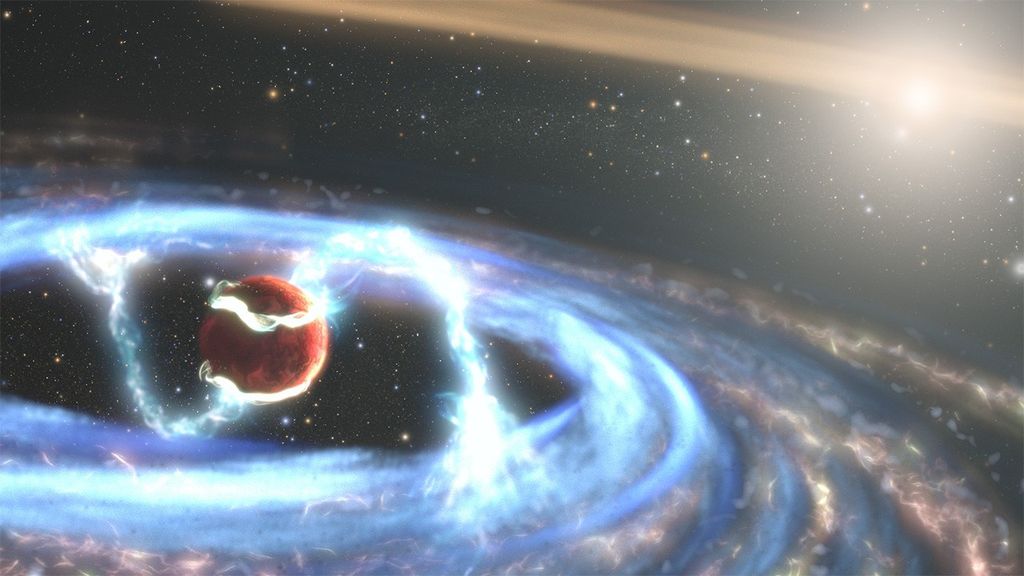Cassini is orbiting Saturn with a 31.9-day period in a plane inclined 44.6 degrees from the planet's equatorial plane. The most recent spacecraft tracking and telemetry data were obtained on September 9 using the 70 meter-diameter Deep Space Network (DSN) station at Goldstone, California. The spacecraft continues to be in an excellent state of health with all of its subsystems operating normally except for the instrument issues described at http://saturn.jpl.nasa.gov/news/significantevents/anomalies. Information on the present position of the Cassini spacecraft may be found on "Eyes on the Solar System".
Cassini spent this week far from Saturn and moving relatively slowly. After apoapsis passage on Thursday, it began its gradual shift to the roller-coaster ride inward again towards a Sept. 19 periapsis. Meanwhile, the flight team sent realtime commands to fire Cassini's main engine again, this time to set up for a Sept. 22 date with Titan.
Saturn, Titan, plus a distant, irregular moon were the objects of Cassini's remote-sensing telescopic science observations, while the magnetospheric and plasma science instruments continued to conduct their direct-sensing measurements of the spacecraft's immediate environment.
Wednesday, Sept. 3 (DOY 246)
The results from the NASA Planetary Science Senior Review, which was conducted in the spring, were released today. They authorize Cassini to complete the final three years of its mission. The project received a rating of "Excellent," the highest rating, in the value of its scientific mission.
The Imaging Science Subsystem (ISS) spent 90 minutes making a Titan cloud monitor observation from a distance of four million kilometers while the Composite Infrared Spectrometer (CIRS) rode along. The Ultraviolet Imaging Spectrograph (UVIS) then started a 16-hour observation of Saturn in the extreme and far-ultraviolet frequencies while CIRS and ISS collected and stored data in ride-along mode. This observation was repeated on Saturday, though for only 13.6 hours, and again on Tuesday for five hours.
A news feature released today reports findings based on Cassini's data that were published this week in the journal Icarus. On Earth we have water-filled aquifers below the surface. On Saturn's planet-like moon Titan, "alkanes" like ethane and methane fill an "alkanofer" just below the cold, wet surface:
http://saturn.jpl.nasa.gov/news/cassinifeatures/feature20140903
Thursday, Sept. 4 (DOY 247)
Cassini coasted past apoapsis just over three million kilometers from Saturn, going 8,200 kilometers per hour relative to the planet. This marked the start of Saturn orbit #208.
CIRS trained its boresight toward one spot on Saturn, and remained pointing at it for 12 hours to determine composition; UVIS and the Visible and Infrared Mapping Spectrometer (VIMS) rode along.
Friday, Sept. 5 (DOY 248)
ISS made another 90 minute Titan cloud observation, with CIRS and VIMS riding this time, and then UVIS spent 10 hours making rapid slews across Saturn's northern auroral oval, with CIRS riding along.
A Cassini flight team member was the guest speaker for "All Space Considered" this evening at the Griffith Observatory in Los Angeles, discussing Cassini's 2017 Grand Finale mission segment.
Saturday, Sept. 6 (DOY 249)
Based on the Navigation team's iterated solutions of Cassini's distant orbital path using the latest tracking data from the DSN, the spacecraft executed commands that the flight team had built and uplinked near real time. The commands turned the spacecraft today and fired its 440 newton main engine, executing Orbit Trim Maneuver (OTM)-390. The liquid bipropellent-fed rocket burn lasted 7.4 seconds, and succeeded in targeting Cassini to the Sept. 22 Titan T-105 encounter. The change in velocity planned, and obtained, was 1.26 meters per second.
Sunday, Sept. 7 (DOY 250)
ISS dedicated 90 minutes to an observation of Saturn with CIRS and VIMS participating as riders. Next, CIRS controlled the spacecraft's pointing for 12 hours, obtaining more spectral data to add to knowledge of Saturn's atmospheric composition. UVIS and VIMS rode along.
The European Planetary Science Congress 2014 meets this week (Sept. 7-12), in Cascais, Portugal. Along with numerous Cassini presentations on Saturn, and its rings, magnetosphere, and satellites, there are special sessions on Cassini’s 10 years at Saturn and on Titan’s surface and interior.
Monday, Sept. 8 (DOY 251)
With UVIS riding, ISS made a long-distance, long-duration observation of Saturn's small irregular moon Kiviuq. A very dark-surfaced object only about 14 kilometers in diameter, Kiviuq’s namesake is an eternal hero, the wandering shaman of Inuit mythology. The icy object follows an inclined, eccentric orbit as far as 11.11 million kilometers out from the planet. Cassini's precisely pointed telescopes had no trouble tracking this wanderer for a solid 24 hours.
Saturn's narrow, ever-changing F ring, which is located just outward from the main rings, was the subject of a news feature released today: http://saturn.jpl.nasa.gov/news/cassinifeatures/feature20140908
Part of the F ring, plus the fuzzy-edged shadow of Saturn, and the little moon Pan inside the A ring, can be seen in an image featured today: /resources/16092
Tuesday, Sept. 9 (DOY 252)
This week, the DSN communicated with and tracked Cassini on eight occasions, using stations in Australia and California. A total of 17 individual commands were uplinked, and about 1,570 megabytes of telemetry data were downlinked. Along with the usual tracking data used by navigation, there were also nine hours of Radio Science data collected for calibration to prepare for the T-106 flyby. Cassini also participated in one more Project Interface Test of the newly constructed 34 meter-diameter station in Australia.


































